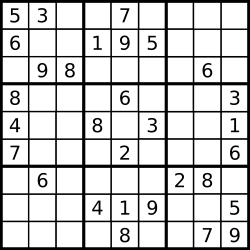Leetcode#36. Valid Sudoku
Problem
Determine if a 9 x 9 Sudoku board is valid. Only the filled cells need to be validated according to the following rules:
- Each row must contain the digits
1-9without repetition. - Each column must contain the digits
1-9without repetition. - Each of the nine
3 x 3sub-boxes of the grid must contain the digits1-9without repetition.
Note:
- A Sudoku board (partially filled) could be valid but is not necessarily solvable.
- Only the filled cells need to be validated according to the mentioned rules.
Example 1:

1 | Input: board = |
Example 2:
1 | Input: board = |
Constraints:
board.length == 9board[i].length == 9board[i][j]is a digit1-9or'.'.
Solve
sol1暴力解
1 | class Solution: |
sol2
1 | class Solution: |
特殊解
直接計算個數方法
1 | class Solution(object): |
本部落格所有文章除特別聲明外,均採用 CC BY-NC-SA 4.0 許可協議。轉載請註明來自 Imisky!
評論
